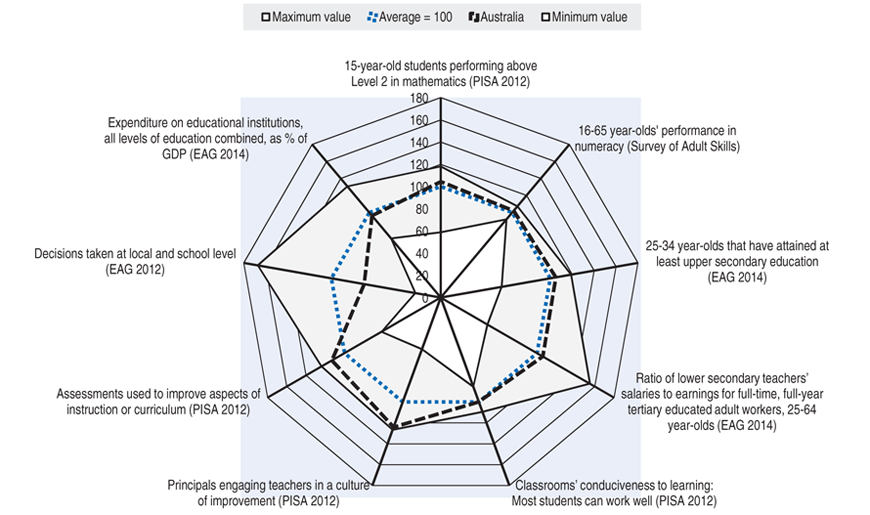Australia
Education Policy Outlook Snapshot: Australia
Australia’s educational contextStudents: Australia performs above the OECD average in PISA 2012, with decreasing performance in mathematics and reading and unchanged performance in science across PISA cycles. Australia has fewer underperforming students than the OECD average, and the impact of students’ socio-economic background on performance is below average. However, rural as well as Aboriginal and Torres Strait Islander populations have lower academic performance and less access to tertiary education than the national average. A high proportion of children are enrolled in early childhood education, and school is comprehensive until age 16. School choice is widely available compared to the OECD area. Secondary and tertiary pathways aim to prepare students for social integration and entry into the labour market. Attainment rates in upper secondary education are at the OECD average. The enrolment rate in upper secondary vocational education and training is above the OECD average, as is the attainment rate in tertiary education. Compared to their peers in other OECD countries participating in the Survey of Adult Skills, proficiency in literacy among 16-65 year-old Australians is above average. Proficiency in numeracy in this survey is at average, with 16-24 year-olds performing somewhat higher. Unemployment rates in Australia are below the OECD average. Institutions: Australia’s schools have positive learning environments, with autonomy over curriculum and assessment above the OECD average and autonomy over resource allocation (such as hiring and dismissing teachers and budget allocation) at around the OECD average. Teachers at lower secondary level are required to undergo a four-year pre- service training, including a mandatory teacher practicum. Instruction time for students and teachers' teaching time in primary and secondary education are among the highest across OECD countries. At primary and secondary levels, teachers' salaries are also above the OECD average, and class size is around the OECD average. A higher proportion of teachers in Australia than the TALIS average consider that the teaching profession is valued in society and would choose to work as teachers if they could decide again. Moreover, the evaluation and assessment framework is well conceived and can help generate improvements in the classroom with clearer information for schools on areas to improve. System: Australia works in a shared national education system in agreement with states. The education system is steered nationally through agreements with states and territories, focused on education priorities and funding. Schools and states share most decision-making in lower secondary education, with schools making most decisions regarding the organisation of instruction. School funding has lacked transparency and coherence, and outcomes of numerous studies have shown the difficulty in determining how individual schools are funded. Expenditure on educational institutions as a percentage of GDP (for all educational levels combined) is below the OECD average, with a higher share from private sources than the OECD average. Selected indicators compared with the average Click here to access the underlying dataNote: For each indicator, the absolute performance is standardised (normalised) using a normative score ranging from 0 to 180, where 100 was set at the average, taking into account all OECD countries with available data in each case. See www.oecd.org/edu/policyoutlook.htm for maximum and minimum value countries. Source: The Australia Snapshot was produced combining information from Education Policy Outlook: Australia, (OECD, 2013) with OECD data and the country’s response to the Education Policy Outlook Snapshot Survey (2013). More information on the spider chart and sources is available at www.oecd.org/edu/policyoutlook.htm. Click here to access the underlying dataNote: For each indicator, the absolute performance is standardised (normalised) using a normative score ranging from 0 to 180, where 100 was set at the average, taking into account all OECD countries with available data in each case. See www.oecd.org/edu/policyoutlook.htm for maximum and minimum value countries. Source: The Australia Snapshot was produced combining information from Education Policy Outlook: Australia, (OECD, 2013) with OECD data and the country’s response to the Education Policy Outlook Snapshot Survey (2013). More information on the spider chart and sources is available at www.oecd.org/edu/policyoutlook.htm.
Key issues and goalsStudents: Australia’s high education performance can be complemented with further focus on reducing inequities by tackling system-level policies hindering equity in education. Other important issues are strengthening incentives for attaining skills demanded by the labour market and increasing access to education and performance of students from disadvantaged backgrounds and Aboriginal and Torres Strait Islander students. Institutions: Providing continued support for professional development of teachers and school leaders and clearer evaluation and assessment on how schools can improve are among key issues in Australia. System: Another issue needing attention is increasing the clarity of policies and funding within the decentralised education system.
Selected policy responses
|
||||
| Please cite this publication as: OECD (2015), Education Policy Outlook 2015: Making Reforms Happen, OECD Publishing. http://dx.doi.org/10.1787/9789264225442-en |
| Back to the country profiles page |
Permanent URL: www.oecd.org/edu/policyoutlook.htm
OECD work on education: www.oecd.org/education
Related Documents

